OVERVIEW
The Auditorium space types are areas for large meetings, presentations, and performances. Auditorium space type facilities may include assembly halls, exhibit halls, auditoriums, and theaters. Auditorium space types do not include such features as sound reinforcement systems, audiovisual systems and projection screens, food service facilities, proscenium stages with heights greater than 50′- 0″ or fly gallery, orchestra pits, revolving or hydraulic stage platforms, flying balconies, movable seating, or billboard systems.
SPACE ATTRIBUTES
Auditorium spaces are designed to accommodate large audiences. As such, they tend to have wide spans and are multiple-stories high in order to accommodate seating, sightline, and acoustical requirements. Raised stage/dais floors and special lighting equipment are often required as well. Typical features of Auditorium space types include the list of applicable design objectives elements as outlined below. For a complete list and definitions of the design objectives within the context of whole building design, click on the titles below.
Functional / Operational
• Sloped Floors: Sloped floors, with level terraces for each row of seating, help provide the proper sightlines from the audience to the stage. Note that the bottom and intermediate rows should be directly accessible from entry levels to allow for Americans with Disabilities Act Accessibility Guidelines for Buildings and Facilities (ADAAG) compliant accessible seating positions.
• Fixed Seats: Typically, fixed seats with tilting upholstered seat and back, integral arm and tablet arm are provided with articulated back for maximum occupant passage space between rows. The seats may be fully upholstered or wood contoured outer back and seat shells with wood armrests with tablet arm option and aisle light option at row ends. Seat number/row letters should be Americans with Disabilities Act (ADA) compliant. Wheelchair access option-removable seats in sections of two and accessible end chairs for mobility limited occupants should be provided.
• Special Lighting: Dramatic lighting systems include front lighting, foot lighting, spot lights, follow spot lights, beam lights, and flood lights, and a projection room/booth with manual and programmable lighting controls, and space for the spot light operator space. Lighting systems should be flexible to accommodate various performance venues (e.g., lectures, plays, musical performances, etc.) in the Auditorium.
• Occupancy: Occupancy Group Classification is Assembly A1 or A3 as per IBC, with sprinkler protected construction, and GSA Acoustical Class A space requiring special acoustical design.
• Special Acoustical Design: Quality acoustical characteristics are important in Auditorium spaces so that performances and presentations can be clearly heard and understood. For performance spaces and general presentation spaces, recommended noise criteria (NC) rating ranges from NC-20 to NC-30; recommended sound transmission class (STC) rating ranges from STC 40 to STC 50. Strategies to achieve the recommended NC and STC ranges include, for example: Type II vinyl wall covering and fabric covered acoustical wall panels for the interior wall finish in the auditorium; Type II vinyl wall covering for the stage area; Type II vinyl wall coverings for 1/3 of the front of the orchestra (audience) sidewalls and fabric covered acoustical panels for 2/3 of the back of the orchestra (audience) sidewalls; fabric covered acoustical panels for rear walls; and a plaster and plywood combination—because of their reverberation characteristics—for the ceiling.
Acoustic ceilings are made of NRC tiles which absorb most of the sound that goes in that direction.Sound basically doesn’t reflect that much in an auditorium because the walls, ceilings and carpets all are made of absorbing materials and hence sound(noise) is mostly trapped before reaching the stage.The acoustics of a well planned space always take care of this aspect while desgining an auditorium.
Sustainable
• Increased Cooling Capacity: Heating, ventilating, and air-conditioning (HVAC) systems for Auditorium spaces are sized and zoned to accommodate varying internal loads, which are a function of audience sizes, performance lighting loads, and projection equipment. Particularly, air handling units (AHUs) with increased cooling capacity should be zoned separately for the auditorium, lobby, projection spaces, stage areas, and audience seating areas. Also, the Auditorium typically has a separate AHU constant volume with modulated temperature control for ventilation.
• Raised Floor: The recommended system for distribution of HVAC in auditorium spaces is ducted supply through floor vents with ducted ceiling return air vents in auditorium and lobby. In other spaces, ducted ceiling supply with return air ceiling plenum is recommended. Note that there should be transfer ducts at all acoustically rated partitions.
Secure / Safe
• Fire and Life Safety: Proper notification systems, lighting, and signage are required to facilitate safe and speedy evacuations during an emergency in the Auditorium spaces. Step lights recessed into floor risers at each seating tier and wall mounted low light level sconce lights along side walls are typical. Sprinklers should be provided per code and under stage platforms to suppress fires. See also WBDG Secure / Safe—Ensure Occupant Safety and Health andSecure / Safe—Plan for Fire Protection.
STAGE
CHAIRS
AUDITORIUM LAY OUT PLANS, SECTIONS TO UNDERSTAND VIDEO DISPLAY, EYE VISION ON STAGE AND SEATING PLANS































































































































